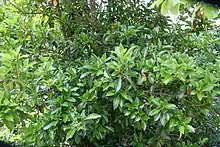| Viburnum odoratissimum | |
|---|---|
 | |
| Viburnum odoratissimum var. awabuki | |
| Scientific classification | |
| Kingdom: | Plantae |
| Clade: | Tracheophytes |
| Clade: | Angiosperms |
| Clade: | Eudicots |
| Clade: | Asterids |
| Order: | Dipsacales |
| Family: | Adoxaceae |
| Genus: | Viburnum |
| Species: | V. odoratissimum |
| Binomial name | |
| Viburnum odoratissimum | |
Viburnum odoratissimum, commonly known as sweet viburnum, is a shrub or small tree in the family Adoxaceae. It is native to Asia, and commonly cultivated as a garden ornamental elsewhere.
Description

Flowers
It grows to 9 metres high and has glossy elliptical leaves to 20 cm long. In spring it produces pyramid-shaped clusters of fragrant white flowers, followed by red berries that age to black.[2]
Distribution and habitat
The species is native to China, Korea, Taiwan, Japan, the Himalayan region in India, Myanmar, Thailand, Vietnam and the Philippines.[1]
V. odoratissimum var. awabuki is native to Korea (Jeju Island), Taiwan, and Japan.[3]
Cultivation
The species prefers warm, frost-free climates.[2]
References
Wikimedia Commons has media related to Viburnum odoratissimum.
- 1 2 "Viburnum odoratissimum". Germplasm Resources Information Network. Agricultural Research Service, United States Department of Agriculture. Retrieved 9 April 2014.
- 1 2 Lord, Ernest Edward; Willis, James Hamlyn (1982). Shrubs and Trees for Australian Gardens. Lothian.
- ↑ "Viburnum odoratissimum var. awabuki". Germplasm Resources Information Network. Agricultural Research Service, United States Department of Agriculture. Retrieved 9 April 2014.
This article is issued from Wikipedia. The text is licensed under Creative Commons - Attribution - Sharealike. Additional terms may apply for the media files.